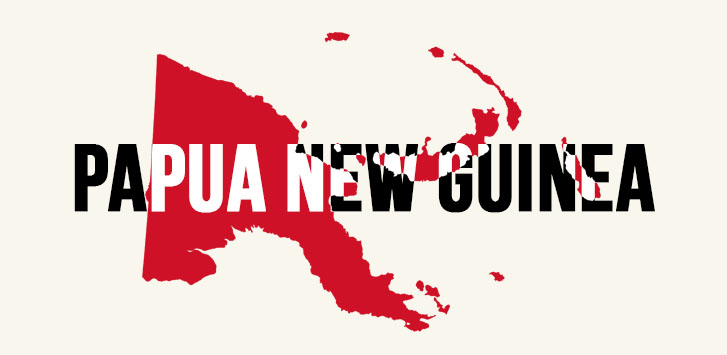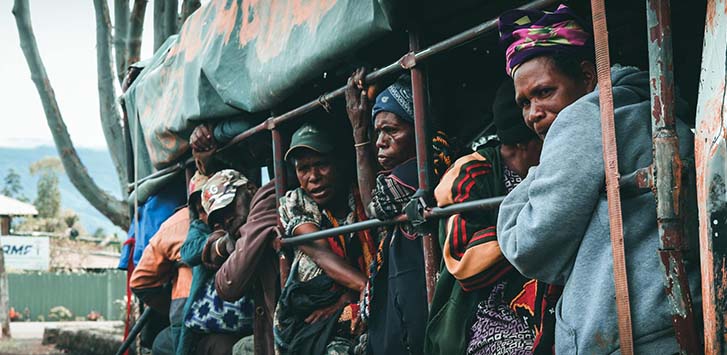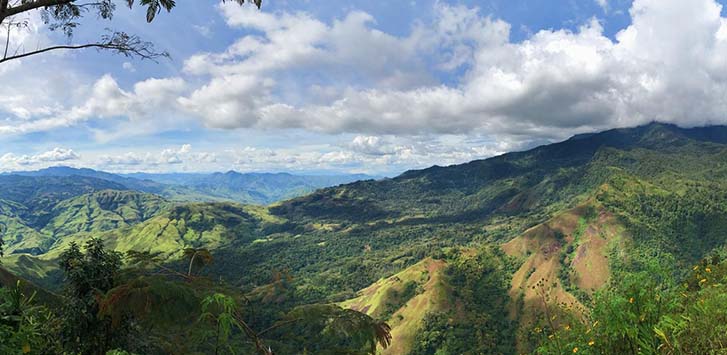
From the country’s early success with large-scale coffee operations to a slow decentralization, coffee from Papua New Guinea is highly prized for its rich chocolate flavors punctuated with a lingering spiciness that is unmatched by just about every other coffee we offer.
If you’re a fanatic about our Sumatran beans and haven’t tried our selections of Papua New Guinea green coffee beans but want to know a bit more about this bean, then our guide is right for you. We break down this bean’s history, flavor profile, roasting suggestions, and more!
History

Like the island of Hispaniola, the country that would become Papua New Guinea was originally colonized by the German Empire in 1884. Soon after New Guinea was carved between the German and the British occupying the east of the country. Meanwhile, the Dutch controlled the territory of Papua which was the western half of the island that was later absorbed into Indonesia before WW1.
Coffee was originally believed to be brought to the island in the 1800s, however, the first recorded instance of coffee coming to the island was in 1926 when Jamaican blue mountain coffee seeds were brought to the island. By the end of the decade, a total of 18 commercial coffee plantations were established in Sangara.
Through the 1960s and 70s, production capabilities, infrastructure, and exports continued to develop in great strides. In 1963, Papua New Guinea established an internal governmental coffee organization, the CIC (the Coffee Industry Corporation) as coffee was becoming a veritable cash crop for the island nation.
As the ’60s gave way to the 1970s, Papua New Guinea continued to ramp up its coffee exports by filling in the gap in the coffee supply as Brazil saw production slump because of frost.
By the 1980s, the larger scale coffee-growing industry of Papua New Guinea started to decline due to its incurred debt and began to decentralize and fracture into small farmers. This downturn was also compounded with the emergence of coffee rust that began to affect crops in areas that previously had no such cases.

With the 80s shifting into the early 1990s, Papua New Guinea coffee exports began to see prices fall. This was especially concerning for the PNG government considering that coffee comprised 42% of the country’s total agricultural revenue, nearly 13% of its total exports. So, in reaction to price instability, the Papua New Guinean government intervened by creating a Coffee Industry Fund to help stabilize prices.
While the shift from large-scale coffee production to small coffee farms has occurred gradually, this has come with a few downsides for the coffee industry within the country. Gone are the days of internal infrastructure that occurred with large-scale farming. The lack of roads between mountainous farms to the coast has been a major roadblock (pun intended) in exporting PNG beans to a wider public.
Additionally, the dual issues of poor agricultural practices alongside climate change have left farmers in dire straits. On top of that, theft from bandits has prevented the government from further developing large-scale growing capabilities at present. An IMF reports nearly 50% of crop yield is stolen before even reaching the market.
Growing Regions
Currently, five out of the 22 provinces within Papua New Guinea account for nearly 90% of total coffee production in the country. These provinces are the Western Highlands, the Eastern Highlands, Simbu, Morobe, and East Sepik.

Additionally, most coffee grown is of the arabica variety and nearly 80% of this is accomplished by small farms up in the hills (around 1.5k meters or more above sea level) with little to zero government investment and encouragement. Due to this, the quality between lots is highly variable, though, most harvests are wet processed. However, the remaining 20% grown in PNG is done by larger coffee plantations whose more rigorous quality control methods have ensured the aura of Papua New Guinea coffee being high quality.
Much of the harvest (that isn’t stolen on its way to the market) is then usually exported to European and North American markets. Most notable is that Starbucks has begun to invest heavily into ethically sourcing from Papua New Guinean farmers as part of their Starbucks Reserve program.
Flavor Profiles
Given the wide range and variance between farm to farm, there are varying flavors. That being said, most Papua New Guinea coffee is similar to other coffee from the region; like Sumatrans, Java, and Sulawesi. So, if you enjoy your Indonesian beans, but haven’t had a chance to try our PNG beans, you should find yourself loving our selections.
Generally speaking, PNG coffee is well-balanced and full-bodied that possesses rich and deep chocolate flavors that are underpinned with spicy notes and earthy undertones. Another interesting aspect is that a slightly fruity acidity is present.
Two particularly notable coffees from PNG are sourced from the Arona valley of the country and are nearly identical to the earthy and floral Sumatrans. While they come from the Arokara valley and are naturally grown without the use of chemicals.
Roasting Suggestions
Like its Indonesian brothers and other geographically close “cousins”, Papua New Guinean coffee beans tend to come into their own when roasted from medium roasts to dark roasts. These roast stages further accentuate the bean’s already robust spiciness, chocolate notes, and earthy nuttiness.
Brewing Suggestions
There are three brewing methods that we think help further enhance the flavors inherent to PNG beans and depending on your taste you may prefer one over another. However, there’s never any harm in trying all three of our brewing suggestions.
The first brewing method we suggest trying with PNG beans is the humble French Press. We feel that this method intensifies the already rich chocolate notes and earthiness present. This brewing method also allows the coffee bean’s oils to continue to flavor the cup during the steeping period. Just be sure to use coarse grind as anything finer will become over-extracted during the brewing process.
The second brewing method we recommend using is another tried and true method, the pour-over method, but with a steel filter! Like the French Press, this method foregrounds the nuttiness, chocolate flavors, and spicy top-end. We advise against using paper filters for this bean as the paper filters are typically used for pour-overs, as it will absorb the flavorful oils and diminish the cup of coffee overall.
The third and final brewing method that we suggest is espresso. In contrast to highlighting the chocolate and spicy flavors, we’ve found that brewing espresso with PNG beans pulls out the more fruity and floral notes that often can be found in the background of the flavor profile. If you don’t have an expensive home espresso machine, we offer the Aeropress brewer which can get you to get close to the flavor notes.
Conclusion
Hopefully, we’ve put a spotlight on the often-overlooked Papua New Guinea coffee bean. Often overlooked to its more popular “cousins” like the Javanese or Sulawesi, Papua New Guinean beans may be a bit harder to get, but its assertive flavors make it stand out from the crowd. So, if you’re already a fanatic about the variety of Indonesian coffee we carry, our selection of Papua New Guinea coffee beans will be sure to become a fast (and new) favorite.